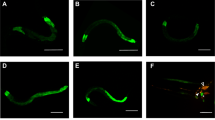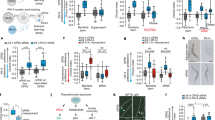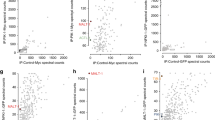Abstract
npr-9 encodes a homologue of the gastrin-releasing peptide receptor (GRPR) and is expressed in AIB interneurons. In this study, we investigated the role of NPR-9 in the neuronal control of innate immunity using the model system Caenorhabditis elegans. After exposure to Pseudomonas aeruginosa PA14, npr-9(tm1652) mutants showed resistance to infection, decreased PA14 colonization and increased expression of immunity-related genes. Nematodes overexpressing NPR-9 exhibited increased susceptibility to infection, increased PA14 colonization and reduced expression of immunity-related genes. In nematodes, ChR2-mediated AIB interneuron activation strengthened the innate immune response and decreased PA14 colonization. Overexpression of NPR-9 suppressed the innate immune response and increased PA14 colonization in nematodes with the activation of AIB interneurons mediated by ChR2 or by expressing pkc-1(gf) in AIB interneurons. We, therefore, hypothesize that NPR-9 regulates the innate immune response by antagonizing the activity of AIB interneurons. Furthermore, expression of GRPR, the human homologue of NPR-9, could largely mimic NPR-9 function by regulating innate immunity in nematodes. Our results provide insight into the pivotal role of interneurons in controlling innate immunity and the complex biological functions of GRPRs.
This is a preview of subscription content, access via your institution
Access options
Subscribe to this journal
Receive 12 digital issues and online access to articles
$119.00 per year
only $9.92 per issue
Buy this article
- Purchase on Springer Link
- Instant access to full article PDF
Prices may be subject to local taxes which are calculated during checkout







Similar content being viewed by others
References
Kurz CL, Ewbank JJ . Caenorabditis elegans: an emerging genetic model for the study of innate immunity. Nat Rev Genet 2003; 4: 380–390.
Sifri CD, Begun J, Ausubel FM . The worm has turned-microbial virulence modeled in Caenorhabditis elegans. Trends Microbiol 2005; 13: 119–127.
Kim DH, Feinbaum R, Alloing G, Emerson EF, Garsin DA, Inoue H et al. A conserved p38 MAP kinase pathway in Caenorhabditis elegans innate immunity. Science 2002; 297: 623–626.
Liberati NT, Fitzgerald KA, Kim DH, Feinbaum R, Golenbock DT, Ausubel FM . Requirement for a conserved Toll/interleukin-1 resistance domain protein in the Caenorhabditis elegans immune response. Proc Natl Acad Sci USA 2004; 101: 6593–6598.
Couillault C, Pujol N, Reboul J, Sabatier L, Guichou J, Kohara Y et al. TLR-independent control of innate immunity in Caenorhabditis elegans by the TIR domain adaptor protein TIR-1, an ortholog of human SARM. Nat Immunol 2004; 5: 488–494.
Liang B, Moussaif M, Kuan C, Gargus JJ, Sze JY . Serotonin targets the DAF-16/FOXO signaling pathway to modulate stress responses. Cell Metab 2006; 4: 429–440.
Irazoqui JE, Ng A, Xavier RJ, Ausubel FM . Role of β–catenin and HOX transcription factors in Caenorhabditis elegans and mammalian host epithelial-pathogen interactions. Proc Natl Acad Sci USA 2008; 105: 17469–17474.
Evans EA, Kawli T, Tan M . Pseudomonas aeruginosa suppresses host immunity by activating the DAF-2 insulin-like signaling pathway in Caenorhabditis elegans. PLoS Pathog 2008; 4: e1000175.
Partridge FA, Gravato-Nobre MJ, Hodgkin J . Signal transduction pathways that function in both development and innate immunity. Dev Dyn 2010; 239: 1330–1336.
Richardson CE, Kooistra T, Kim DH . An essential role for XBP-1 in host protection against immune activation in C. elegans. Nature 2010; 463: 1092–1095.
Roberts AF, Gumienny TL, Gleason RJ, Wang H, Padgett RW . Regulation of genes affecting body size and innate immunity by the DBL-1/MBP-like pathway in Caenorhabditis elegans. BMC. Dev Biol 2010; 10: 61.
Irazoqui JE, Urbach JM, Ausubel FM . Evolution of host innate defense: insights from C. elegans and primitive invertebrates. Nat Rev Immunol 2010; 10: 47–58.
Pukkila-Worley R, Ausubel FM . Immune defense mechanisms in the Caenorhabditis elegans intestinl epithelium. Curr Opin Immunol 2012; 24: 3–9.
Kawli T, Tan M . Neuroendocrine signals modulate the innate immunity of Caenorhabditis elegans through insulin signaling. Nat Immunol 2008; 9: 1415–1424.
Zhang X, Zhang Y . Neural-immune communication in Caenorhabditis elegans. Cell Host Microbiol 2009; 5: 425–429.
Anyanful A, Easley KA, Benian GM, Kalman D . Conditioning protects C. elegans from the lethal effects of enteropathogenic E. coli through activation of genes that regulate lifespan and innate immunity. Cell Host Microbe 2009; 5: 450–462.
Shivers RP, Kooistra T, Chu SW, Pagano DJ, Kim DH . Tissue-specific activities of an immunity signaling module regulate physiological responses to pathogenic and nutritional bacteria in C. elegans. Cell Host Microbe 2009; 6: 321–330.
Styer KL, Singh V, Macosko E, Steele SE, Bargmann CI, Aballay A . Innate immunity in Caenorhabditis elegans is regulated by neurons expressing NPR-1/GPCR. Science 2008; 322: 460–464.
Singh V, Aballay A . Endoplasmic reticulum stress pathway required for immune homeostasis is neurally controlled by Arrestin-1. J Biol Chem 2012; 287: 33191–33197.
Powell JR, Kim DH, Ausubel FM . The G protein-coupled receptor FSHR-1 is required for the Caenorhabditis elegans innate immunity response. Proc Natl Acad Sci USA 2009; 106: 2782–2787.
Sun J, Singh V, Kajino-Sakamoto R, Aballay A . Neuronal GPCR controls innate immunity by regulating noncanonical unfold protein response genes. Science 2011; 332: 729–732.
Lang R, Gundlach AL, Kofler B . The galanin peptide family: receptor pharmacology, pleiotropic biological actions, and implications in health and disease. Pharmacol Ther 2007; 115: 177–207.
Bendena WG, Boudreau JR, Papanicolaou T, Maltby M, Tobe SS, Chin-Sang ID A . Caenorhabditis elegans allatostatin/galanin-like receptor NPR-9 inhibits local search behavior in response to feeding cues. Proc Natl Acad Sci USA 2008; 105: 1339–1342.
Brenner S . The genetics of Caenorhabditis elegans. Genetics 1974; 77: 71–94.
Wu Q-L, Qu Y-Y, Li X, Wang D-Y . Chromium exhibits adverse effects at environmental relevant concentrations in chronic toxicity assay system of nematode Caenorhabditis elegans. Chemosphere 2012; 87: 1281–1287.
Nouara A, Wu Q-L, Li Y-X, Tang M, Wang H-F, Zhao Y-L et al. Carboxylic acid functionalization prevents the translocation of multi-walled carbon nanotubes at predicted environmental relevant concentrations into targeted organs of nematode Caenorhabditis elegans. Nanoscale 2013; 5: 6088–6096.
Zhao Y-L, Wu Q-L, Tang M, Wang D-Y . The in vivo underlying mechanism for recovery response formation in nano-titanium dioxide exposed Caenorhabditis elegans after transfer to the normal condition. Nanomedicine 2014; 10: 89–98.
Diaz SA, Mooring EQ, Rens EG, Restif O . Association with pathogenic bacteria affects life-history traits and population growth in Caenorhabditis elegans. Ecol Evolut 2015; 5: 1653–1663.
Wang D-Y, Cao M, Dinh J, Dong Y-Q . Methods for creating mutations in C. elegans that extend lifespan. Methods Mol Biol 2013; 1048: 65–75.
Mello C, Fire A . DNA transformation. Methods Cell Biol 1995; 48: 451–482.
Kramer RH, Mourot A, Adesnik H . Optogenetic pharmacology for control of native neuronal signaling proteins. Nat Neurosci 2013; 16: 816–823.
Kocabas A, Shen C, Guo ZV, Ramanathan S . Controlling interneuron activity in Caenorhabditis elegans to evoke chemotactic behaviour. Nature 2012; 490: 273–278.
Kamath RK, Martinez-Campos M, Zipperlen P, Fraser AG, Ahringer J . Effectiveness of specific RNA-mediated interference through ingested double stranded RNA in C. elegans. Genome Biol 2001; 2: 1–10.
Alper S, McBride SJ, Lackford B, Freedman JH, Schwartz DA . Specificity and complexity of the Caenorhabditis elegans innate immune response. Mol Cell Biol 2007; 27: 5544–5553.
Kang C, Avery L . Systemic regulation of starvation response in Caenorhabditis elegans. Genes Dev 2009; 23: 12–17.
Sieburth D, Ch’ng Q, Dybbs M, Tavazoie M, Kennedy S, Wang D et al. Systematic analysis of genes required for synapse structure and function. Nature 2005; 436: 510–517.
Sieburth D, Madison JM, Kaplan JM . PKC-1 regulates secretion of neuropeptides. Nat Neurosci 2007; 10: 49–57.
Mills H, Wragg R, Hapiak V, Castelletto M, Zahratka J, Harris G et al. Monoamines and neuropeptides interact to inhibit aversive behaviour in Caenorhabditis elegans. EMBO J 2012; 31: 667–688.
White JG, Southgate E, Thomson JN, Brenner S . The structure of the nervous system of the nematode Caenorhabditis elegans. Philos Trans R Soc Lond B Biol Sci 1986; 314: 1–340.
Nathoo AN, Moeller RA, Westlund BA, Hart AC . Identification of neuropeptide-like protein gene families in Caenorhabditis elegans and other species. Proc Natl Acad Sci USA 2001; 98: 14000–14005.
Ishikawa-Brush Y, Powell JF, Bolton P, Miller AP, Francis F, Willard HF et al. Autism and multiple exostoses associated with an X;8 translocation occurring within the GRPR gene and 3’ to the SDC2 gene. Hum Mol Genet 1997; 6: 1241–1250.
Acknowledgements
Several nematode strains used in this study were provided by the CGC, which is funded by NIH Office of Research Infrastructure Program (P40 OD010440).
Author information
Authors and Affiliations
Corresponding author
Ethics declarations
Competing interests
The authors declare no conflict of interest.
Additional information
Supplementary Information for this article can be found on the Cellular & Molecular Immunology website
Supplementary information
Rights and permissions
About this article
Cite this article
Yu, Y., Zhi, L., Wu, Q. et al. NPR-9 regulates the innate immune response in Caenorhabditis elegans by antagonizing the activity of AIB interneurons. Cell Mol Immunol 15, 27–37 (2018). https://doi.org/10.1038/cmi.2016.8
Received:
Revised:
Accepted:
Published:
Issue Date:
DOI: https://doi.org/10.1038/cmi.2016.8
Keywords
This article is cited by
-
Dissecting the genetic landscape of GPCR signaling through phenotypic profiling in C. elegans
Nature Communications (2023)
-
Paeoniflorin increases the survival of Pseudomonas aeruginosa infected Caenorhabditis elegans at the immunosuppression stage by activating PMK-1, BAR-1, and EGL-1 signals
Archives of Pharmacal Research (2023)
-
Biosafety assessment of Acinetobacter strains isolated from the Three Gorges Reservoir region in nematode Caenorhabditis elegans
Scientific Reports (2021)
-
Mitochondrial hydrogen peroxide positively regulates neuropeptide secretion during diet-induced activation of the oxidative stress response
Nature Communications (2021)



